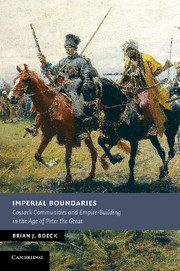Book contents
- Frontmatter
- Contents
- List of maps and illustrations
- Acknowledgments
- List of abbreviations
- 1 The Don region
- 2 The wider world of the Don steppe frontier
- Introduction
- 1 Beyond borders, between worlds: Russian Empire and the making of the Don steppe frontier
- 2 People and power on the frontier: liberty, diversity, and de-centralization in the Don region to 1700
- 3 A middle ground between autonomy and dependence: the raiding economy of the Don steppe frontier to 1700
- 4 Boundaries of integration or exclusion? Migration, mobility, and state sovereignty on the southern frontier to 1700
- 5 Testing the boundaries of imperial alliance: cooperation, negotiation and resistance in the era of Razin (1667–1681)
- 6 Between Rus' and Rossiia: realigning the boundaries of Cossack communities in a time of migration and transition (1681–1695)
- 7 The era of raskol: religion and rebellion (1681–1695)
- 8 Incorporation without integration: the Azov interlude (1695–1711)
- 9 From frontier to borderland: the demarcation of the steppe and the delegitimization of raiding (1696–1710)
- 10 Boundaries of land, liberty, and identity: making the Don region legible to imperial officials (1696–1706)
- 11 The Bulavin uprising: the last stand of the old steppe (1706–1709)
- 12 Reshaping the Don in the imperial image: power, privilege, and patronage in the post-Bulavin era (1708–1739)
- 13 Closing the Cossack community: recording and policing the boundaries of group identity (1708–1739)
- 14 A borderline state of mind: the closing of the Don steppe frontier (1708–1739)
- Afterword
- Index
- References
11 - The Bulavin uprising: the last stand of the old steppe (1706–1709)
Published online by Cambridge University Press: 12 January 2010
- Frontmatter
- Contents
- List of maps and illustrations
- Acknowledgments
- List of abbreviations
- 1 The Don region
- 2 The wider world of the Don steppe frontier
- Introduction
- 1 Beyond borders, between worlds: Russian Empire and the making of the Don steppe frontier
- 2 People and power on the frontier: liberty, diversity, and de-centralization in the Don region to 1700
- 3 A middle ground between autonomy and dependence: the raiding economy of the Don steppe frontier to 1700
- 4 Boundaries of integration or exclusion? Migration, mobility, and state sovereignty on the southern frontier to 1700
- 5 Testing the boundaries of imperial alliance: cooperation, negotiation and resistance in the era of Razin (1667–1681)
- 6 Between Rus' and Rossiia: realigning the boundaries of Cossack communities in a time of migration and transition (1681–1695)
- 7 The era of raskol: religion and rebellion (1681–1695)
- 8 Incorporation without integration: the Azov interlude (1695–1711)
- 9 From frontier to borderland: the demarcation of the steppe and the delegitimization of raiding (1696–1710)
- 10 Boundaries of land, liberty, and identity: making the Don region legible to imperial officials (1696–1706)
- 11 The Bulavin uprising: the last stand of the old steppe (1706–1709)
- 12 Reshaping the Don in the imperial image: power, privilege, and patronage in the post-Bulavin era (1708–1739)
- 13 Closing the Cossack community: recording and policing the boundaries of group identity (1708–1739)
- 14 A borderline state of mind: the closing of the Don steppe frontier (1708–1739)
- Afterword
- Index
- References
Summary
The Bulavin uprising was the most significant act of coordinated opposition to Petrine policies, but the devastating crushing of the rebellion has long been overshadowed by epic events that took place only months after the fiercest fighting on the Don: the dramatic defection of the Ukrainian hetman Mazepa to the Swedes in late 1708 and the victory of Russian forces at Poltava in early 1709. Moreover, the scale of devastation in the Don region rarely merited mention in Russian recitations of Peter's Greatness, which tended to emphasize his role as creator and founder, not destroyer.
This episode also demonstrates the complexity of Russian empire-building. This was no simple story of imperial aggression meeting local resistance. Peter I initially managed to win the loyalty of about as many Don Cossacks as he alienated. The Bulavin uprising was first and foremost a conflict about who could be considered a Cossack, but imperial intervention turned it into a military struggle between the Don and Rus'.
Historians have tended to ignore the fact that in the final stages of the rebellion Bulavin articulated a vision of Cossacks and nomads, Muslims and true Orthodox Christians fighting in unison to save the steppe from Russian encroachment. Recent studies of Russia's engagement with the steppe did not discuss this consciously defined attempt to reject Petrine modes of empire-building. Bulavin first attempted to revive the kind of negotiation characteristic of Peter's predecessors, then he sought Ottoman patronage and military support from the Zaporozhian Cossacks and Tatars.
- Type
- Chapter
- Information
- Imperial BoundariesCossack Communities and Empire-Building in the Age of Peter the Great, pp. 172 - 186Publisher: Cambridge University PressPrint publication year: 2009

